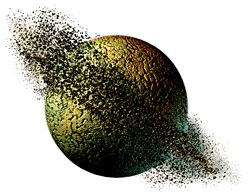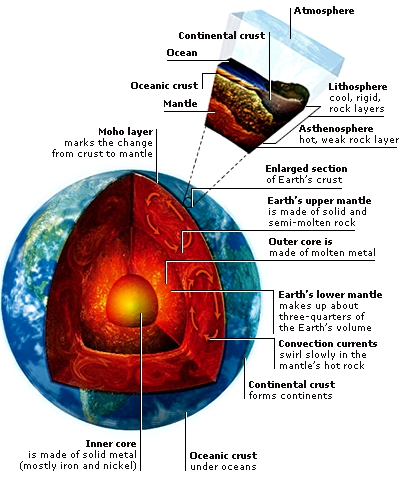DK Science: Earth's Structure
The Earth is a giant, spinning ball of rock and metal. The rocky surface we live on is the Earth’s thin outer layer, called the crust. In places the crust is just a few kilometres thick. Underneath the crust are two more layers, called the mantle, and the core, which combine to reach a depth of 6,370 km (3,960 miles). Scientists discovered these layers by studying how shock waves from earthquakes change direction and speed as they travel through the Earth. It is thought that the core creates Earth’s MAGNETOSPHERE.
The Earth came into being about 4,600 million years ago. Along with the other planets and moons in our Solar System, it was made from material left over after the birth of the Sun. Earths surface has gone through many changes since, with the formation of the continents, oceans, and atmosphere, ’and the appearance of life.

Small particles of rock, dust, and gas in space are gradually pulled together by the gravity between them. The process is called accretion. The young Earth was formed by accretion over millions of years.

Huge pressure in the centre of Earth created heat that melted the rocks inside. For hundreds of millions of years the surface was bombarded by meteorites from space. About 4,200 million years ago, Earth’s surface had cooled and a crust of solid rock had formed.

The early atmosphere consisted of volcanic gases, which formed rain. From about 3,500 million years ago, this began to collect in oceans. Continents were also developing. Simple organisms in the oceans gave out oxygen into the atmosphere.

An imaginary slice out of the Earth shows that scientists believe it has a core made mostly of solid and molten iron, a mantle of solid and half-molten rock, and a crust of solid rock. The inside of the Earth is still extremely hot. Plate tectonics, mountain building, and erosion are constantly changing the appearance of the Earth’s surface.
Geophysicist Andrija Mohorovicic found that earthquake shock waves sped up when they reached about 20 km (12 miles) below the surface. He suggested that happened at a boundary where two different layers of material met. This boundary is between the crust and the mantle, and is now known as the Mohorovicic discontinuity, or Moho.
The Earth has a magnetic field around it, and the magnetosphere is the region in which this field can be felt. It stretches more than 60,000 km (37,000 miles) into space, like an invisible magnetic bubble, and protects the Earth from harmful solar radiation. The solar wind, particles which stream from the Sun, pull the magnetosphere into a teardrop shape.
The Earth has a magnetic field that is the same shape as that of a bar magnet. It is as though the Earth contains a giant bar magnet with its poles located near the North Pole and South Pole. These magnetic Poles are tilted at a slight angle to the Earth’s axis. Scientists think that the magnetic field is caused by currents of molten metal in the Earth’s outer core. From time to time, these reverse, with north becoming south.
William Gilbert was physician to Queen Elizabeth I of England. He was also the first person to realize that the Earth has a magnetic field similar to that of a bar magnet. He proved this by comparing the direction and tilt of a compass needle out in the openwith its direction and tilt when held beside a model of the Earth containing a bar magnet.
